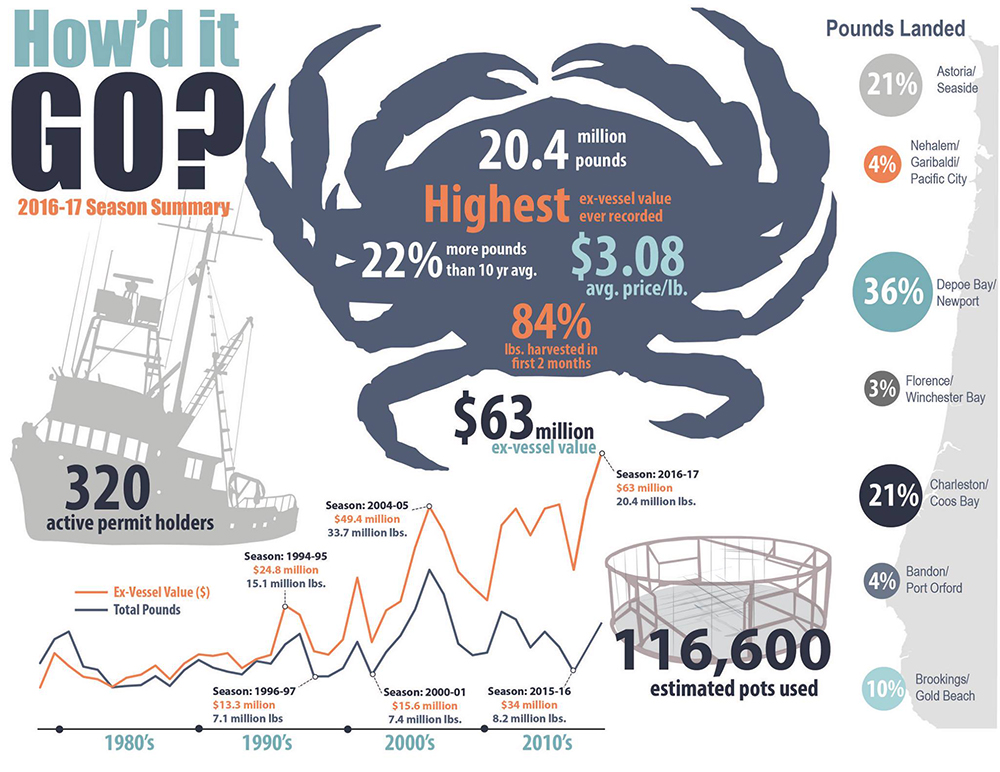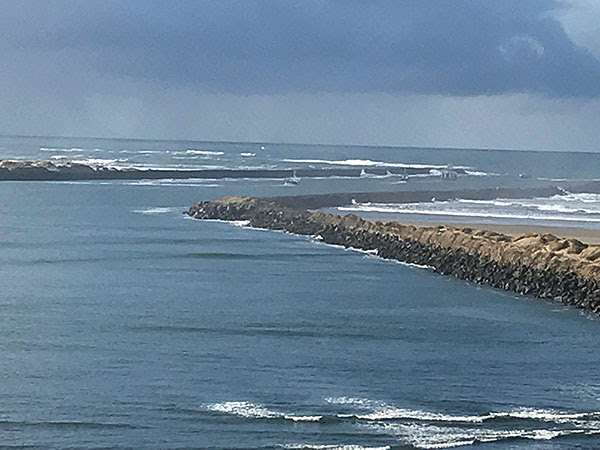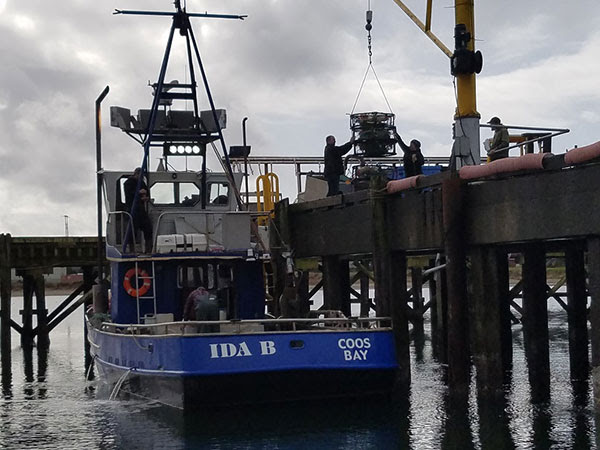Fish Report for 1-24-2018
Oregon’s valuable Dungeness crab fishery gets underway

by ODFW
1-24-2018
Website
And they’re off! Oregon’s most valuable commercial fishery for the state’s official crustacean, Dungeness crab, got underway north of Cape Blanco yesterday.
This year’s opening was delayed from its target start date of Dec. 1 because testing of crabs on some parts of the Pacific coast showed crabs were low in meat yield. In partnership with the Oregon Dungeness Crab Commission and the commercial crab industry, ODFW collects and quality tests crabs out of the six major crabbing ports before the season begins. The season can be delayed if the meat yield doesn’t meet a certain standard, which means that consumers get a high quality product with plenty of meat. (The goal is 23 or 25 percent meat recovery depending on the area, or 9-10 oz. of crab meat for a crab weighing 2.5 pounds.) Failure to achieve a negotiated opening price and intense coastal storms also delayed the opening a few days after Jan. 15.

Dungeness crab have been harvested commercially along the Pacific Coast since the late 1800s. Current regulations allow only male crabs larger than 6 ¼ inches across the back of the shell to be taken. This protects the female and undersized male crabs which constitute the breeding population and produce the next generation of crab to be harvested in about four years, ensuring the sustainability of the overall stock and the industry.
This regulatory approach is working. Preliminary results from a NOAA study show that the population of legal-size males appears to be stable to increasing on the West Coast. Harvest rates are also stable to increasing. Last season’s ex-vessel value (or average price) set a record of $62.7 million, with landings totaling 20 million pounds, 22 percent above the 10-year average.
Vessels returning to Newport had the most pounds of crab landed last year, followed by Astoria and Coos Bay. A little over 300 fishing boats bring crab into Oregon each season. The industry is an important economic driver in Oregon’s coastal towns.

Commercial crabbing starts in the winter, when crabs are hard-shelled and full of meat. State natural resource agencies in Oregon, Washington and California cooperate as part of what’s known as the Tri-State Agreement. They jointly set a season opening date for the area from Point Arena, Calif. to Grays Harbor, Wash., or divide it into two areas with different opening dates. This helps to ensure that the fishery is fair and certain areas aren’t over-targeted while others are closed.
While domoic acid did not play a role in this year’s delayed opening for the northern area, the fishery south of Cape Blanco remains closed because at least some crabs are still above the domoic acid action level. Toxins present an ongoing concern for the state and the industry, and Oregon has a monitoring and response system in place for shellfish to protect public health and manage the risk of contamination.
Oregon Department of Agriculture oversees the collection and testing of shellfish samples. Crabs are sampled every two to four weeks when toxins are above a certain level in razor clams or another indicator species. If a single crab tests above the action level (20 parts per million for meat, 30 for viscera), that harvest area is closed and any crabs taken recently by the commercial industry are not sold to consumers. (When viscera is above 30 ppm but meat is below 20 ppm, managers can sometimes order that crab be eviscerated rather than doing a full closure.) It takes two clean tests, taken at least seven days apart, for ODA and ODFW to reopen the harvest area.
Since the first ever in-season commercial closure of a harvest area last year (when a single crab’s viscera tested too high for domoic acid), ODFW, ODA and the industry have adopted new rules to improve traceability in the market chain, resulting in better preparation and response to future domoic acid events.
Efforts to reduce commercial crabbing’s impact on the environment and other marine species are also underway. Since 2014, a derelict gear removal program collecting abandoned crab pots or other equipment has been in place. Commercial crabbers removed 957 old pots from the ocean in 2017 alone. A collaborative working group involving industry, agencies, and conservation organizations is also looking at ways to modify gear and other measures to reduce the risk of whale entanglements.
“We’re looking forward to many more years of a successful commercial crab industry and sustainable resource in Oregon,” said Troy Buell, ODFW state fishery program leader.
More Reports
1st meeting of Coordinating Council on Ocean Acidification and Hypoxia

1-24-2018
Oregon’s new Coordinating Council on Ocean Acidification and Hypoxia (OAH) will host its first meeting on Thursday, Jan. 25 from 10...... Read More
A and H Program Jan. 24 teleconference meeting to discuss new Coos Mtn TMA

1-23-2018
The Access and Habitat Board will host a teleconference call on Wednesday, Jan. 24 at 9:30 a.m. to discuss a possible new...... Read More

Website Hosting and Design provided by TECK.net